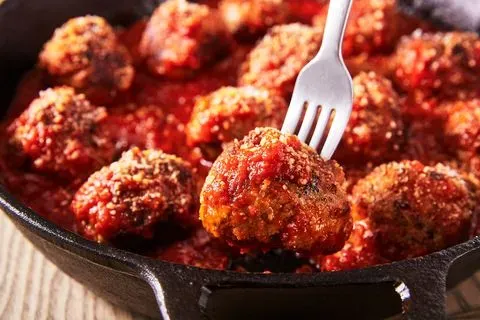Table of Contents
Let's be real, making truly great meatballs isn't just about rolling ground meat into balls and hoping for the best. If you've ever had those dense, flavorless orbs, you know the struggle. Many chase that elusive, tender, juicy result that tastes like it came straight from a nonna's kitchen. Often, the secret sauce – or rather, the secret meat – lies in the blend. We're talking about the classic 3 meat Italian meatballs, the kind that combine ground beef, pork, and veal.
Why the 3 Meat Italian Meatball Blend Matters

Why the 3 Meat Italian Meatball Blend Matters
Alright, let's talk about the foundation of a truly great meatball: the meat itself. You might think ground beef is enough, but if you want that authentic, tender, juicy bite, you need the trifecta. This is precisely why the 3 meat Italian meatball blend matters so much. Ground beef brings the robust, familiar flavor and structure. But lean beef alone makes for a dense, dry meatball. Enter pork. Pork, with its higher fat content, is the moisture carrier. It keeps things tender and adds a richness that beef lacks on its own. Then there's veal. Veal is the delicate touch, contributing to that melt-in-your-mouth texture that separates a good meatball from a phenomenal one. Using just one or two meats leaves you with a compromise – either too dry, too dense, or lacking depth. The specific ratio can vary, but the combination of these three is non-negotiable for classic Italian-American style meatballs.
Crafting the Perfect Mix for Your 3 Meat Italian Meatballs

Crafting the Perfect Mix for Your 3 Meat Italian Meatballs
Beyond the Meat: The Non-Negotiable Ingredients
Getting the meat blend right is step one, but honestly, the other stuff you throw in makes or breaks your 3 meat Italian meatballs. Think of it like a supporting cast – they don't get top billing, but the show fails without them. You absolutely need breadcrumbs. Fresh breadcrumbs, made from slightly stale bread, are ideal because they absorb moisture beautifully without turning gummy. Store-bought dry breadcrumbs work too, just make sure they're plain. Parmesan cheese is non-negotiable; shred it yourself from a good quality block. Pre-shredded stuff has anti-caking agents that mess with texture and flavor. Fresh garlic, finely minced, provides that essential aromatic punch. Forget the jarred stuff; it just doesn't taste the same. And don't skimp on fresh parsley – it adds brightness that cuts through the richness.
Binding and Seasoning: Getting the Ratio Right
Now, let's talk about binding and flavor boosters for your 3 meat Italian meatballs. Eggs are crucial for holding everything together. Use just enough; too many make the meatballs rubbery. Milk, or sometimes water or even red wine, helps moisten the breadcrumbs and keeps the mixture tender. Start with a little liquid and add more if the mix feels dry, but don't make it mushy. Seasoning is where you make it yours. Salt and black pepper are obvious, but a pinch of red pepper flakes adds a subtle warmth, and a little nutmeg is surprisingly traditional and adds depth. The key is to mix everything gently. Overworking the meat develops tough proteins, leading to those leaden results nobody wants. Mix until everything is just combined – no need to knead it like bread dough.
- Use fresh breadcrumbs for best texture.
- Shred Parmesan from a block, avoid pre-shredded.
- Always use fresh garlic and parsley.
- Bind with eggs and moisten with milk or water.
- Season generously with salt, pepper, and maybe nutmeg.
- Mix gently to keep meatballs tender.
Cooking Methods for Killer 3 Meat Italian Meatballs
you've got your perfect blend, your non-negotiable ingredients are prepped, and the mix is just right. Now comes the moment of truth: cooking your 3 meat Italian meatballs. You've got options, but let me tell you, skipping the browning step is a rookie mistake. Searing those meatballs in a hot pan, preferably with a little olive oil, develops a beautiful crust and locks in moisture. This isn't just for looks; it adds a crucial layer of flavor through the Maillard reaction. After they're browned on all sides – which takes just a few minutes per batch – the classic move is to simmer them gently in your marinara sauce. This allows them to finish cooking through while absorbing all that rich tomato flavor. You can also bake them after browning, which can be less messy, but simmering is the traditional way to get that deeply integrated flavor.
Serving and Storing Your Delicious 3 Meat Italian Meatballs

Serving and Storing Your Delicious 3 Meat Italian Meatballs
Serving Up Your Masterpiece
So you've done the hard work: sourced the right meats, prepped the perfect binding ingredients, and coaxed those beautiful 3 meat Italian meatballs through the cooking process, likely simmering away in a rich marinara. Now comes the payoff. Serving these bad boys is pretty straightforward, but a few things elevate the experience. Classic spaghetti is the obvious choice, letting the meatballs and sauce coat the pasta beautifully. Make sure your pasta is perfectly al dente. Don't drown the pasta; add the sauce and meatballs to the cooked pasta in the pan and toss gently to combine. A sprinkle of fresh Parmesan (the good stuff, remember?) and a few torn basil leaves are non-negotiable finishing touches. These 3 meat Italian meatballs also shine in a sub roll, perhaps with some melted provolone, or even just served simply as an appetizer with crusty bread for soaking up the sauce.
Keeping the Magic Alive: Storing Leftovers
Let's face it, unless you're feeding a small army, you'll likely have leftovers of your delicious 3 meat Italian meatballs. And honestly, they often taste even better the next day as the flavors meld. Proper storage is key to maintaining quality and safety. Once the meatballs and sauce have cooled completely (don't leave them out for hours), transfer them to an airtight container. Glass containers are great as they don't stain or hold odors like plastic can. Get them into the refrigerator within two hours of cooking. They'll keep well in the fridge for 3-4 days. Don't just shove the whole pot in; portioning them into smaller containers makes reheating easier and faster.
- Refrigerate within 2 hours of cooking.
- Use airtight containers.
- Leftovers are good for 3-4 days in the fridge.
- Portion into smaller containers for easy reheating.
Freezing for Future Feasts
Maybe you made a massive batch of 3 meat Italian meatballs, or maybe you just want to stash some away for a rainy day emergency meal. Freezing is your friend. You can freeze them cooked and in the sauce, or even uncooked. If freezing cooked meatballs in sauce, cool completely, then transfer to freezer-safe containers or heavy-duty freezer bags. Squeeze out as much air as possible to prevent freezer burn. They'll last in the freezer for 3-4 months. For uncooked meatballs, place them on a baking sheet lined with parchment paper and freeze until solid. Then transfer the frozen, uncooked 3 meat Italian meatballs to a freezer bag. This flash-freezing prevents them from sticking together. Thaw frozen meatballs (cooked or uncooked) overnight in the refrigerator before reheating or cooking.
The Last Bite: Mastering the 3-Meat Meatball
So, there you have it. The mystery behind the truly great 3 meat Italian meatballs isn't really a mystery at all; it's a combination of common sense and respecting your ingredients. The blend of beef, pork, and veal isn't some old wives' tale; it's a practical approach to texture and flavor. Getting the mix right, using decent cheese, and understanding that cooking isn't just about heating them through but building layers of taste – these are the things that separate the contenders from the imposters. Don't overwork the meat, don't skip the browning, and for the love of all that is good, grate your own damn cheese. Follow these simple steps, and you might just find yourself making meatballs that don't just fill a plate, but actually get talked about.